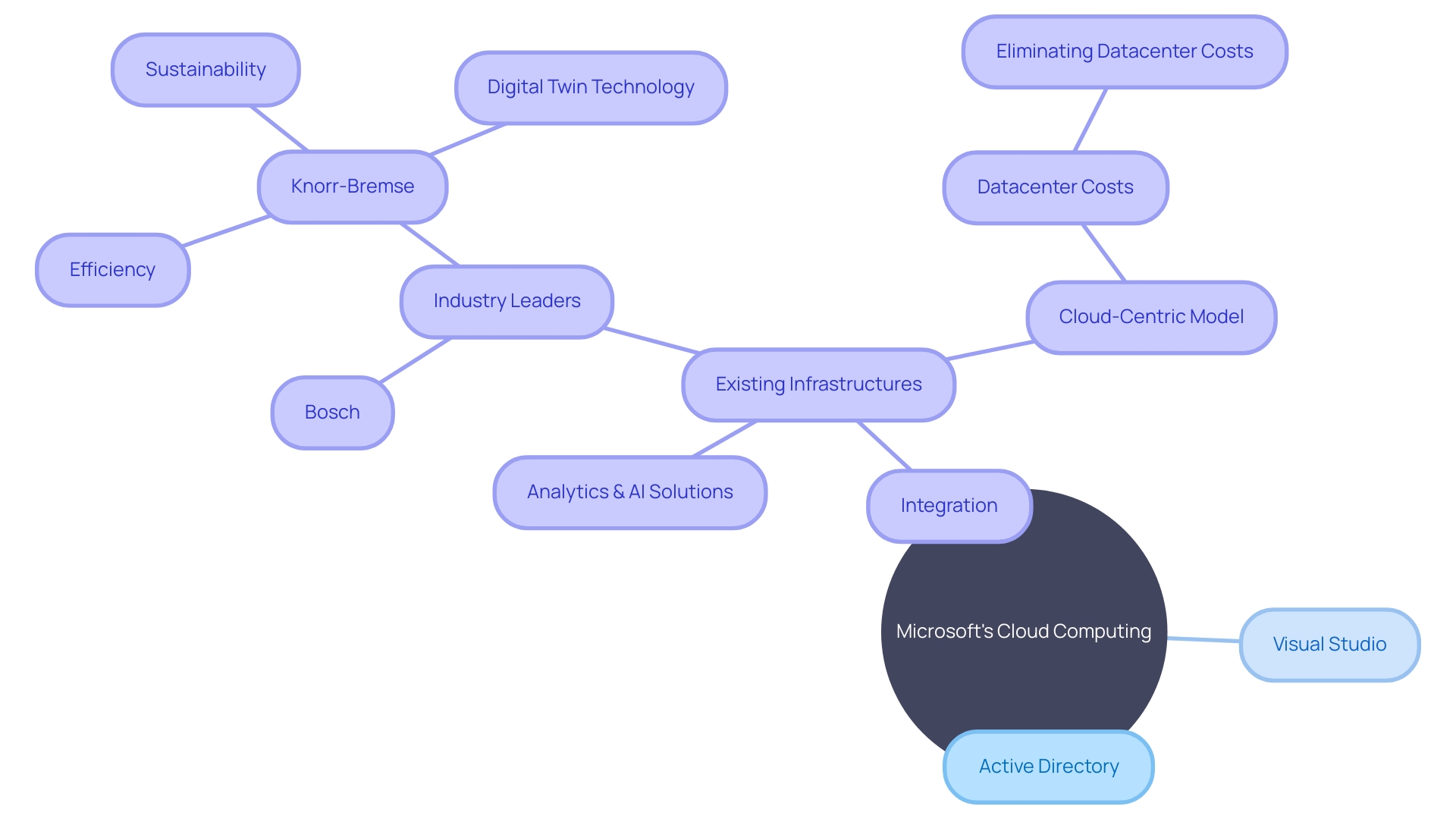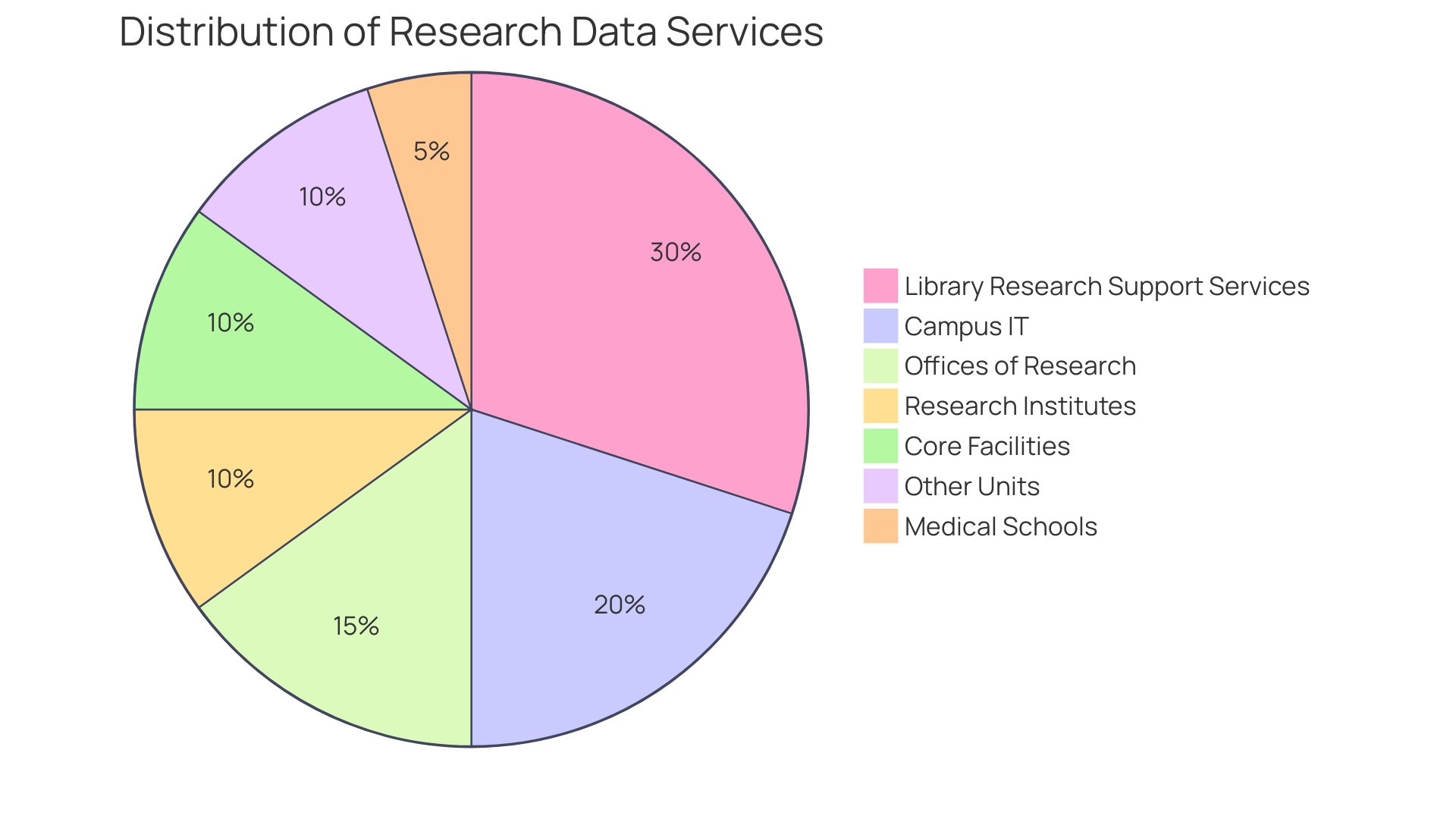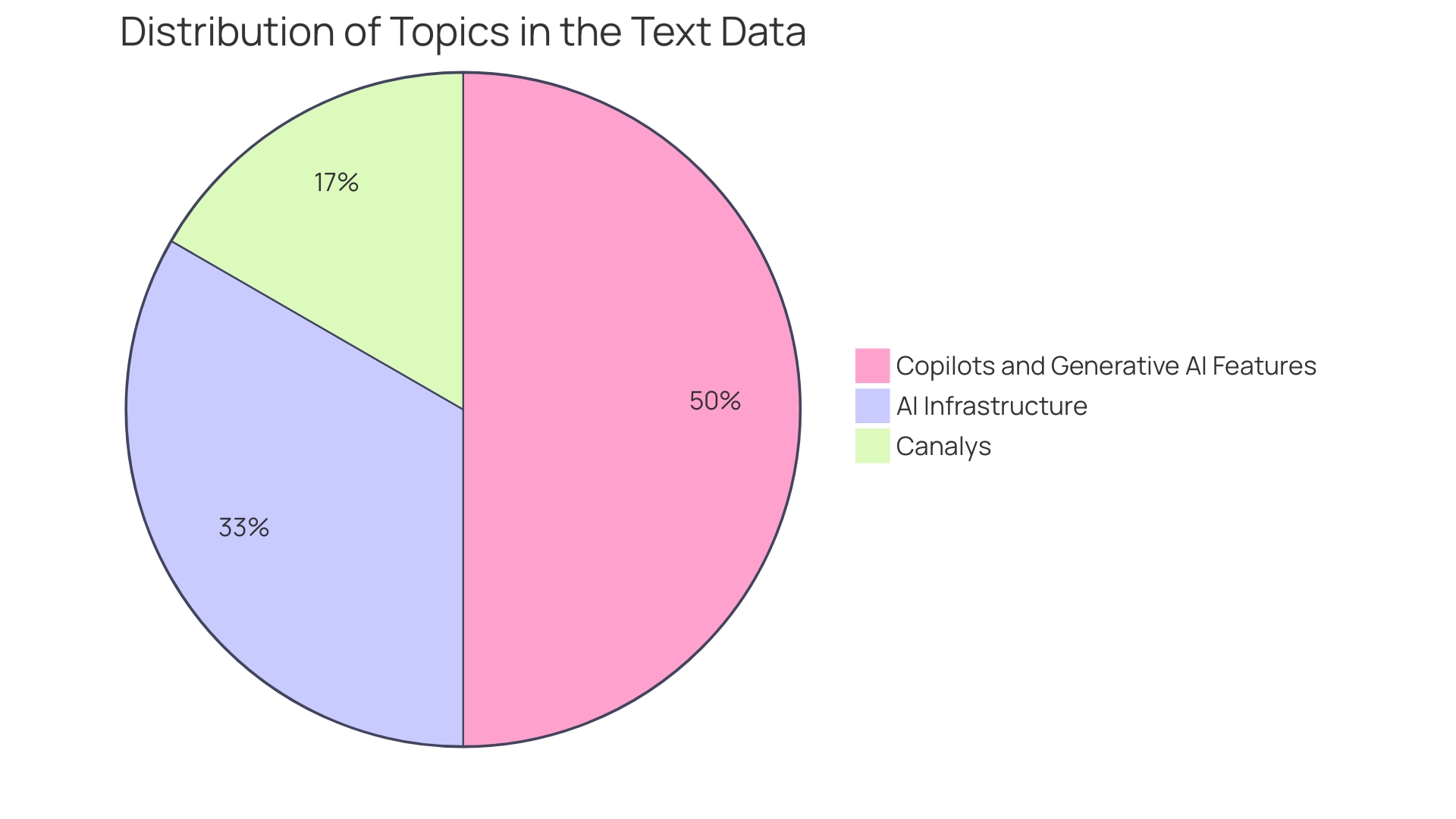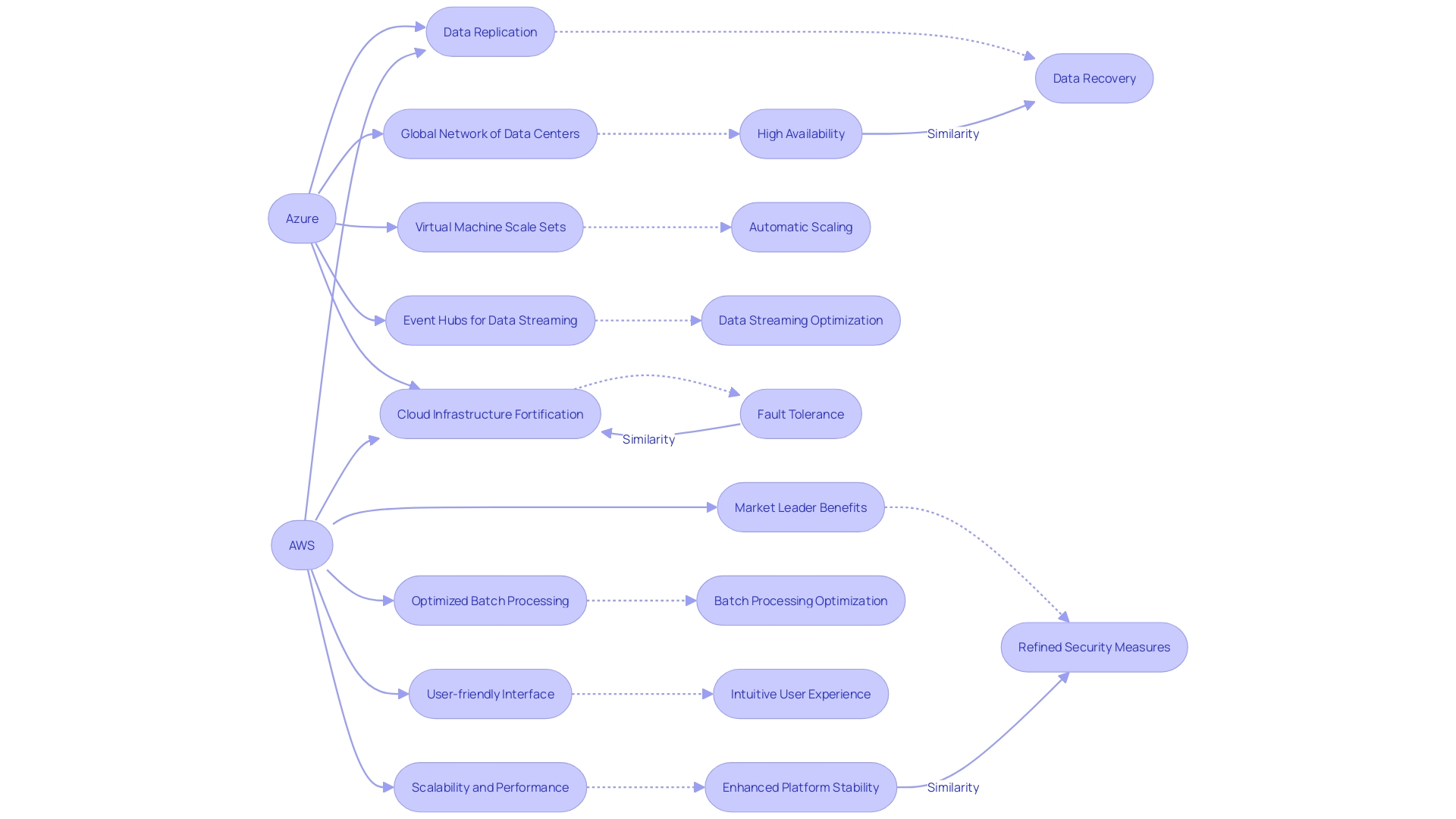Introduction
Azure, Microsoft's powerful cloud computing platform, offers a multitude of benefits for enterprises looking to integrate seamlessly with Microsoft's ecosystem. With its native support for widely-used tools and its Azure Active Directory, Azure provides an effortless bridge for extending identity and access management into the cloud. This level of integration is exemplified by industry leaders like Bosch and Knorr-Bremse, who have successfully leveraged Azure to enhance their existing Microsoft-based infrastructures.
Azure's robust hybrid cloud capabilities, pricing and cost efficiency, security and compliance features, integration with Microsoft products, open source support and Linux compatibility, storage and data management solutions, machine learning and AI capabilities, user experience and ease of use, scalability and performance are all factors that make Azure a compelling choice for organizations seeking innovative and reliable cloud solutions.
Enterprise Integration and Ecosystem
It serves as a guiding light for integration, especially for enterprises that have already embraced the extensive suite of products offered by the tech giant. The platform's synergy with Microsoft's ecosystem is evident in its Active Directory, which offers an effortless bridge for extending on-premises identity and access management into the cloud environment. For developers, the friendliness of the cloud computing platform extends to its inherent support for widely-used tools like Visual Studio, simplifying the build, test, and deployment pipeline for applications. Such smooth integration showcases the ability of Microsoft's platform to not just coexist with but also improve existing infrastructures based on Microsoft, echoing the strategic technology approaches observed in industry leaders like Bosch and Knorr-Bremse. Bosch's deployment of their innovative solid oxide fuel cell system, benefiting from digital twin technology to optimize long-term performance, reflects their own commitment to efficiency and sustainability. Meanwhile, Knorr-Bremse's transition to a cloud-based platform, as articulated by IT Director Thomas Auer, signifies a strategic pivot towards a cloud-centric model, aiming to eliminate datacenter costs and bolster their digitization journey. These cases highlight the transformative potential of the ecosystem provided by Microsoft's cloud computing platform, especially when combined with Microsoft's analytics and AI solutions, as demonstrated by Microsoft Fabric and the AI services offered within Azure, creating a strong platform for enterprise innovation and growth.

Hybrid Cloud Capabilities
Hybrid computing solutions have become a pivotal component of modern IT strategies, especially as companies navigate the complexities of post-COVID-19 realities and the swift pace of technological change. Azure Stack demonstrates Azure's robust support for hybrid environments, enabling organizations to smoothly extend their on-premises centers into the realm of cloud computing. This integration enables a unified hybrid experience, essential for businesses that need to manage the extensive capabilities of the cloud while ensuring information control and compliance adherence.
Notably, the synergy of Microsoft's cloud platform with its existing on-premises solutions offers a distinct convenience that resonates with the strategic needs of companies. For example, Knorr-Bremse, a leader in vehicle safety systems, utilized a cloud-based platform to transition towards a remote infrastructure, aligning with their vision of becoming a data-driven enterprise and reducing data center expenses.
While AWS provides hybrid capabilities through AWS Outposts, the deep-rooted compatibility of Azure with on-premises systems is particularly beneficial for 'Microsoft houses' like IFCO, where a partnership with Rackspace leveraged their migration to the cloud, enhancing their global infrastructure strategy.
Moreover, as Gartner's research indicates, the demand for a unified platform that accommodates both innovation and operations is growing. Organizations are aiming to combine different projects and initiatives, necessitating a dependable and integrated hybrid approach that Azure is well-equipped to provide.
Despite the absence of a universally preferred deployment model, the inclination towards hybrid arrangements continues to rise. As businesses like 4Wall Entertainment seek to modernize IT infrastructure, the choice between public cloud services and on-premises data centers is becoming less of an 'either-or' decision and more of an integrated solution, blending the strengths of both environments to meet the evolving demands of the market.

Pricing and Cost Efficiency
Microsoft's cloud computing platform offers a pricing model that caters to the dynamic needs of businesses, presenting a pay-as-you-go structure for optimal cost management. This model ensures that expenses align closely with actual consumption, thereby enabling organizations to scale their resources in tandem with their operational demands. The Reserved Instances program, introduced by the same company, promises significant savings—up to 72% when compared to on-demand prices—when commitments are made for extended usage durations.
Moreover, the Hybrid Benefit initiative is particularly remarkable for its cost-saving implications. It allows the use of current licenses for specific Microsoft products in the on-premises environment. This consideration for current investments not only underscores the adaptability of Azure's pricing strategies but also reflects a recognition of the importance of optimizing the overall cost of migrating to and operating in the cloud.
The commitment to cost-efficiency is further exemplified by their ongoing efforts to optimize cloud computing through sophisticated algorithms, capable of identifying near-optimal solutions under constraints of time and computational resources. Such technological innovation is crucial in addressing the complexities that emerge with the expansion of services, hardware, and VMs.
To help organizations in making the most informed procurement choices, the platform offers a range of tools and features designed for effective cost allocation. As stated by the FinOps Foundation, cost allocation is pivotal in dividing a consolidated invoice to bill the responsible parties based on resource consumption and benefit application. The resource hierarchy of a certain cloud computing platform, which includes management groups, subscriptions, and resource groups, enables the process of cost tracking, budgeting, and forecasting, thereby enhancing accountability and transparency within the organization.
The approach of Microsoft's cloud computing platform is enhanced by the recent announcement at Microsoft Ignite 2023 concerning the FinOps open cost and usage specification (FOCUS) dataset, which simplifies consumption and processing of information. The incorporation of both real and amortized expenses in a unified dataset is a clear indication of the company's approach to simplify the data ingestion process, thus generating extra efficiencies.
According to Mark Russinovich, the Chief Technology Officer of Azure, 'You require a platform that enables you to expand effortlessly, access new markets, utilize the latest technologies, and the most competitive pricing in a constantly evolving digital landscape.' This vision is achieved through the expansion of its global footprint and diversification of regions, offering customers with more options, flexibility, and resiliency for their solutions.
The pricing innovations and optimization efforts, coupled with the strategic regional growth and dedicated tools for cost management, embody a comprehensive approach to cloud computing that strongly resonates with the requirements of modern organizations.
Security and Compliance
The platform exemplifies commitment to security and compliance, offering a suite of tools designed to safeguard data and adhere to various regulatory standards. The Security Center provides advanced threat detection and mitigation capabilities, while Active Directory delivers strict identity and access management solutions. The comprehensive compliance certifications of Microsoft's cloud platform cater to a range of industry-specific regulations, ensuring that businesses can confidently meet compliance demands. AWS offers similar robust security features, but it sets itself apart with its seamless integration with Microsoft's suite of security solutions, potentially providing a more cohesive security and compliance posture.
For businesses with an international customer base, the strategic choice between Azure and AWS can be influenced by regional information protection laws. As observed in the case of Skyflow, an AWS Partner, navigating the complexities of global privacy regulations is crucial. Companies like Skyflow, which operate with a product-led growth strategy and have customers across the globe, must ensure compliance with regulations that govern data storage locations, such as those mandated by the European Union. This consideration is crucial when selecting a provider that can enable compliance with such legal requirements without obstructing business growth.
In the realm of Infrastructure as a Service (IaaS), the shared responsibility model places specific security obligations on the customer. While both Azure and AWS provide tools for securing resources, it is incumbent upon IT professionals to implement them effectively. Common pitfalls include leaving encryption disabled, which exposes information to potential breaches. As a result, organizations must be diligent in their use of security tools to protect applications, data, and user access.
Supporting the sentiment of Fively's recommendation, AWS is acknowledged for its user-friendly interface, which differs from the more complex navigation of Azure's. This ease of use is significant, given the importance of reducing the learning curve for technical teams. AWS's historical presence in the market has nurtured a large developer community and an extensive repository of documentation, which are invaluable resources for resolving technical challenges.
Furthermore, as highlighted by industry experts, both Azure and AWS offer high availability and fault tolerance by distributing data and computational workloads across multiple data centers globally. This design guarantees the uninterrupted operation of business and disaster recovery, showcasing the resilience of online services. It is crucial for organizations to consider these attributes when evaluating cloud providers, as they directly impact the reliability and resilience of business operations.
Integration with Microsoft Products
The profound integration of Azure with the ecosystem of the tech giant offers distinctive advantages for enterprises that are already utilizing the services provided by the company. Integration with widely-used applications such as Office 365, SharePoint, and Dynamics 365 enables businesses to capitalize on their existing technology investments. This synergy enhances productivity by creating streamlined workflows and providing users with a unified experience that is not only efficient but also familiar. Such integration is particularly beneficial for organizations that are entrenched in the ecosystem of the tech giant, as Azure acts as a natural extension to their current infrastructures. Noteworthy is the consistent delivery of new products and enhancements, spurred by substantial R&D efforts, which aim to boost customer productivity and security. The company's dedication to innovation is demonstrated by its regular product updates and its focus on Environmental, Social, and Governance (ESG) initiatives, reflecting a forward-thinking approach in serving its customers' evolving needs. As evidenced by the positive feedback from industry experts, such as recognition in the 2024 Gartner® Magic Quadrant™ for Integration Platform as a Service, the integration capabilities of this cloud service provider are a compelling reason for organizations to consider it as their provider of choice.
Open Source Support and Linux Compatibility
Microsoft's cloud computing platform is continuously advancing its support for open source technologies, distinguishing itself as a formidable platform for organizations that prioritize open source compatibility and Linux-based deployments. Users have access to a broad spectrum of Linux distributions, including industry favorites like Ubuntu, Red Hat, and CentOS. In addition, the marketplace provided by Microsoft's cloud computing platform now includes 'Red Hat Enterprise Linux (RHEL) for Third-Party Linux Migration with Extended Life Cycle Support (ELS)', improving the efficiency and cost-effectiveness of migrations and operations.
The dedication of the company to open source is shown through its involvement in notable community events. The Open Source Summit North America 2024 and KubeCon Europe 2024 are prime examples where Microsoft actively contributes to and supports the cloud-native community. Furthermore, the recent initiatives of the company, including the introduction of ONNX Runtime Web with WebGPU, showcase its commitment to empowering developers with state-of-the-art open-source tools.
The inclusion of open source in Microsoft's cloud computing platform is further highlighted by the transition of LinkedIn's operating system to Azure Linux, underscoring the platform's capability to handle complex, mission-critical workloads with enhanced stability, security, and performance. The approach of a certain cloud computing service provider towards open source not only promotes technological innovation but also offers organizations the power, control, and customization they require—all at competitive prices.
The practical benefits of the open source support offered by Azure's platform are evident in the significant reduction of resource provisioning time, where tasks that once took over a week can now be completed in just a few hours. This accelerates the delivery of new solutions to the market, offering tangible advantages to businesses aiming to stay ahead in a fast-paced technological landscape.
Furthermore, the 2024 OSSRA report underscores the necessity of understanding the components within your codebase, especially with the prevalence of open source. With 96% of commercial software containing open source components, and an average of 526 open source elements per application, the importance of efficient, automated security testing solutions like software composition analysis (SCA) is clearer than ever.
In summary, the robust support for open source technologies and Linux compatibility by the cloud computing platform demonstrates its strategic dedication to meeting the changing requirements of the market, providing a seamless experience for organizations utilizing open source frameworks and tools.
Storage and Data Management
The extensive range of storage services offered by Azure is tailored to meet the evolving needs of businesses, providing scalable and cost-effective solutions for managing diverse types of information. Using Blob Storage, organizations can easily manage unstructured information on a large scale. The Files service provides a cloud-based solution for fully managed file shares, ensuring seamless accessibility and collaboration. The strong Disk Storage provides high-performance block storage, optimized for virtual machines, while Lake Storage empowers businesses to store and process vast amounts of information with ease.
Ensuring the safety of sensitive information remains a top priority for the cloud computing platform, which implements comprehensive measures like network security and encryption. The identity and access management of the cloud platform, together with threat protection, provide extra layers of security, strengthening its dedication to ensuring the integrity of information.
Cost considerations are crucial when deploying cloud services, and understanding the pricing structure is essential. The pricing of Azure's services varies, with certain services billing based on the volume of information processed and others based on the number of operations.
In the context of worldwide information expansion, estimated to achieve 175 zettabytes by 2025, the services provided by Azure not only offer long-lasting storage choices but also tackle the requirement for environmentally friendly archival solutions. Conventional magnetic storage technologies such as tapes and hard disks, which necessitate regular migration of information, are overshadowed by the advanced and enduring storage solutions provided by Azure.
The recent increase in storage and services from the cloud computing platform highlights its ability to support new workloads and changing access patterns. The integration of AI and machine learning technologies in the cloud platform further enhances its storage capabilities, providing cutting-edge solutions for modern challenges in managing information.
As the cloud computing landscape evolves, the platform continues to differentiate itself with its robust security, flexible and scalable services, and strategic integration with Microsoft's ecosystem. These qualities make a compelling choice for organizations seeking innovative and reliable data management solutions.
Machine Learning and AI Capabilities
The expertise of a certain company in the field of artificial intelligence (AI) and machine learning (ML) clearly establishes it as a frontrunner, setting it apart from AWS. With a deep commitment to AI and ML, this platform is equipped with a robust array of services such as Machine Learning, Cognitive Services, and Bot Service, allowing enterprises to develop, implement, and scale AI-infused applications with ease. The compatibility of Microsoft's cloud computing platform with renowned ML frameworks, including TensorFlow and PyTorch, bolsters its allure for ML-centric enterprises. The AI and ML capabilities of AWS are significant, however, the extensive services offered by another cloud platform, combined with its smooth integration with Microsoft's AI and ML ecosystems, give it a competitive edge.
The practical consequences of this technological dominance are apparent in the creation of inventive applications that utilize the AI capabilities of the platform. By showcasing the evolution of AI through a chat application built on a particular cloud computing service, the platform's capability to integrate advanced features like multi-language voice support and sophisticated access to information is demonstrated. This aligns with the recent advancements in the infrastructure of the cloud computing platform, including the integration of One Lake and a suite of tools within the Microsoft ecosystem, aimed at streamlining data analysis for intricate, data-intensive applications.
The commitment to AI is further underpinned by the substantial investment in security and privacy, with over 3,500 security experts ensuring the protection of data. This is complemented by an attractive pay-as-you-go consumption model, with an initial free credit and access to many popular services at no cost, providing a financially flexible entry point for organizations.
As AI continues to drive innovation across various business sectors—most notably in marketing, sales, and product development—Azure's AI services emerge as a key player. The pre-built AI capabilities of AI services enable natural communication methods in apps, with minimal coding required to implement features like vision and object detection.
The era of AI is upon us, with Microsoft's cloud infrastructure evolving to support these cutting-edge technologies. Indeed, the integration of AI into everyday operations is no longer a distant possibility but an immediate reality that demands attention from all competitive businesses.

User Experience and Ease of Use
Organizations appreciate the user-centric design and seamless integration of the cloud platform with widely used development tools, such as Visual Studio, which simplifies the development lifecycle. Visually appealing and user-friendly, the portal for Microsoft's cloud services streamlines navigation and resource management. In the words of Denise Dourado from Microsoft UK, Visual Studio serves as an 'integrated development environment' allowing developers to write, edit, and debug their code in one location, significantly reducing the complexity of software development. This harmonious integration not only addresses the challenges developers face today but also echoes the sentiment from a classic Visual Studio advert about the transformative impact of using the right tools. Moreover, the extensive support materials of the platform enable organizations to quickly embrace and optimize it. Although AWS is also user-friendly, the commitment of another cloud provider to a refined user experience, coupled with its robust development ecosystem, positions it as a highly regarded choice for many enterprises.
Meanwhile, emerging technologies like AI are shaping the industry's future, as evidenced by the Ford Foundation's initiative to integrate advanced AI capabilities into their operations. The capability of scaling effortlessly meets the demands of such innovative applications, ensuring developers can adapt to rapid technological advancements. The industry's shift towards AI and optimization algorithms, which is crucial for configuring complex environments across diverse servers and VMs, emphasizes the significance of the capability to handle intricate workloads. As Canalys highlights, the technology industry is evolving, and the forward-thinking approach of Microsoft's cloud platform to seamless integration and optimization stands out, aligning with the need for smart market insights and advanced technology solutions.
Scalability and Performance
When considering the scalability and performance of cloud infrastructure, one particular cloud provider stands out with its robust global network of data centers. This extensive presence allows for the deployment of applications and services in close proximity to users, minimizing latency and enhancing performance. The Virtual Machine Scale Sets feature from Microsoft's cloud platform is evidence of its commitment to optimizing performance, as it offers automatic scaling according to current demand. This ensures not only peak performance but also cost-efficiency, which is crucial for organizations juggling multiple cloud-based services and applications.
On the other hand, AWS's scalability and performance are also commendable, but the dedication to performance of the other cloud provider stands out. For instance, GoDaddy, with a customer base exceeding 20 million, relies on data-driven insights and has optimized its batch processing jobs using a structured approach. This emphasis on efficiency reflects the dedication of the platform to continuous improvement and optimization.
Moreover, the capability of the cloud platform to handle intricate optimization algorithms is advantageous for organizations that handle a range of servers, VMs, and operating systems. Such algorithms are essential for generating nearly optimal solutions within reasonable timeframes and computational resources, a challenge that many cloud providers encounter, but one that is tackled directly.
In the realm of data streaming from applications, Event Hubs offers a competitive edge with features like partitioned logs and consumer groups. Despite the similarities with platforms like Apache Kafka, the integrated environment and managed services of this platform simplify operations for users. Fively's advice supports this notion, suggesting that AWS generally provides a more user-friendly experience, but the advancements of another cloud provider should not be overlooked when weighing options for cloud services.
These terms obscure. Both Azure and AWS contribute to these developments by ensuring data and code are replicated across multiple data centers, providing a safeguard against data center failures and fortifying the overall cloud infrastructure.

Conclusion
In conclusion, Azure's integration with Microsoft's ecosystem, support for widely-used tools, and robust hybrid cloud capabilities make it a compelling choice for enterprises. The platform's pricing and cost efficiency, security and compliance features, open source support, and Linux compatibility further enhance its appeal.
Azure seamlessly integrates with Microsoft's ecosystem, streamlining workflows and enhancing productivity. Its support for open source technologies and Linux compatibility caters to organizations prioritizing these technologies.
With a comprehensive suite of storage services, Azure offers scalable and cost-effective solutions for managing diverse data types. Its security measures and flexible pricing model ensure data integrity and align costs with usage.
Azure's machine learning and AI capabilities position it as a leader in the field. Services like Azure Machine Learning and Azure Cognitive Services enable enterprises to develop and scale AI-infused applications with ease.
The platform's user-centric design, seamless integration with development tools like Visual Studio, and commitment to continuous improvement contribute to a positive user experience. Azure's scalability and performance, supported by its global network of data centers, provide optimal performance and cost-efficiency.
In summary, Azure's integration, capabilities, and commitment to meeting the evolving needs of modern organizations make it a compelling choice for reliable and innovative cloud solutions.




